桃[Prunus persica(L.)Batsch]是原产我国的世界性重要落叶果树,栽培历史悠久,适应范围广,经济效益高。在中国果业中仅次于柑橘、苹果和梨,居第四位。桃蚜(Myzus persicae Sülze)是桃树早春的主要害虫之一,对桃产业危害严重。目前中国农业科学院郑州果树研究所已经培育了多个桃树抗蚜品种,正处于区试和品种保护阶段。应用桃树抗蚜品种能有效防治桃树桃蚜危害,在桃树抗蚜品种大规模推广前,对抗蚜品种田间昆虫种类和数量的变化趋势进行研究,可为抗蚜品种配套植保措施的制定提供必要信息。
桃蚜通常以若虫、成虫群集于桃树新梢幼嫩叶片背面刺吸汁液造成叶片卷缩,无法抽出嫩梢。桃蚜分泌的蜜露污染植物叶片,易引起煤污病,影响植物光合作用。此外,桃蚜还是植物病毒病的携带者和传播者[1]。由于桃蚜具有繁殖快、个体小、生活周期短的特点,在生产上需要花费大量的人力物力多次喷施农药进行防治,长期使用农药不仅会使桃蚜对农药产生抗药性,还给环境带来了巨大的化学污染。因此,利用桃树自身抗性防控桃蚜是最环保和经济的一种方式。
在过去50到60年里,植物育种家和昆虫学家在使用传统的植物育种方法培育抗虫作物品种方面取得了较大的成功,在自然界中发现了许多对昆虫有抗性的资源品种[2]。植物的抗性是由昆虫诱导的植物蛋白质和抗性基因产物合成的防御化物质介导的。利用克隆和分子定位已确定Mi-1.2 和Vat 节肢动物抗性基因为CC-NBS-LRR(coiled coil-nucleotide binding site-leucine rich repeat)亚家族NBS-LRR抗性蛋白,以及多个抗性基因类似物。遗传连锁定位已识别出100多个用于品种培育的植物抗性基因位点和连锁分子标记[3-6]。目前,在世界范围内,已从桃种质资源中鉴定出多份抗蚜材料。法国农科院鉴定了5种抗蚜种质,其中“垂枝花桃”(Weeping Flower Peach,WFP)和桃砧木品种Rubira 分别由显性单基因位点Rm1 和Rm2 控制,山桃为多基因控制,主效基因定位在3号染色体上[7-9]。王力荣等[10]采用田间自然筛选和人工接种相结合的方法,对国家果树种质郑州桃圃保存的419 份资源进行了抗桃蚜鉴定,筛选出了寿星桃、碧桃抗性较强的种质资源。笔者课题组培育出多个桃树的抗蚜品种并且对蚜虫的抗性效果显著[1,11-14]。我国抗虫品种研发成果丰硕,近年来抗虫作物陆续被批准商业化生产,世界范围内迄今已有200余个带有抗虫性状的转基因玉米品种被批准商业化生产[15]。20年来,我国共批准3188个转基因抗虫棉生产应用安全证书,其中,2572 个获得品种审定[16]。抗虫棉的应用不仅能有效控制棉铃虫对棉花的危害,还能减少棉铃虫对其他作物的危害[17-18]。相对于常规棉花,抗虫棉的种植降低了农药使用量、减少了防治成本[19-21]。但是随着抗虫棉的大量种植,一些非靶标害虫(如棉蚜、棉盲蝽、烟粉虱等)因农药施用量减少而出现大暴发的现象[22-24]。
已有研究表明如BT 棉等抗虫作物在长期种植过程中会影响田间非靶标害虫种群种类和数量,导致次要害虫升级为重要害虫,从而影响作物害虫防治的周年规律[25-32]。目前桃树抗蚜品种种植对田间昆虫群落结构的影响尚缺乏研究。为此,笔者在本研究中对桃树抗蚜品种种植后田间昆虫群落种类和数量变化进行调查,旨在探明抗蚜品种的应用推广对除桃蚜外的昆虫种类和数量造成的影响,为将来抗蚜品种应用推广后可采用的植保措施提供科学参考和理论依据。
1 材料和方法
1.1 试验时间、地点
试验于2022 年3—8 月在中国农业科学院郑州果树研究所新乡综合试验基地桃育种课题组育种圃进行。
1.2 试验材料及处理
供试材料选用感蚜品种中油13 号和抗蚜品种中蟠1 号(抗性来源于寿星桃,属于I 类抗性),由中国农业科学院郑州果树研究所桃育种课题组提供。
试验共设2个处理,分别为抗蚜地块(种植抗蚜品种中蟠1 号)和对照地块(种植感蚜品种中油13号)。两个地块面积相同,地块内桃树的株行距1 m×3 m,3 年生树,树形为主干形,桃树地面自然生草。对照地块正常防治桃蚜,在桃蚜发生季节使用2 次防治蚜虫的农药,于桃树花露红时(3 月14 日)第1次喷施农药,种类为22%氟啶虫胺腈悬浮剂10 000倍液和20%氯氰菊酯水乳剂600 倍液;于桃树落花后(4月7日)第2次喷施农药,种类为22%氟啶虫胺腈悬浮剂10 000 倍液、20%氯氰菊酯水乳剂600 倍液、22.4%螺虫乙酯悬浮剂6000 倍液和500 g·L-1甲基硫菌灵悬浮剂400倍液。抗蚜地块内不针对蚜虫进行化学防治。此外,针对该桃园往年危害桃树严重的梨小食心虫和红蜘蛛进行化学防治,于4 月10日喷施35%氯虫苯甲酰胺水粉散粒剂7000 倍液防治梨小食心虫,于7月1日喷施10%乙螨唑和20%联苯肼酯悬浮剂5000倍液防治红蜘蛛。
1.3 试验方法
调查采用马来式网收集法、昆虫性诱剂诱捕法和目测法。每隔10 d 左右收集1 次,将收集到的昆虫标本带回实验室进行初步的分类和鉴定,将昆虫鉴定到目。
马来式网收集法:按照均匀分布原则,在每个地块安装1 个马来式网,3 次重复,两个地块共安装6个马来式网。昆虫被诱集于装有75%乙醇的塑料瓶中,保持了昆虫的原始形态,收集后及时更换收集瓶。
昆虫性诱剂诱捕法:每个三角形诱捕器配置1枚诱芯,距地面150 cm。每个地块设4种诱芯处理,每处理2 次重复,两个地块共16 个诱捕器。每个地块内的诱捕器均匀分布,隔21 d 统一更换诱芯。每隔7 d调查并记录诱捕器诱捕到的昆虫数量,并重新清理干净。
目测法:每个地块内随机抽取5 株树,3 次生物学重复,目测调查并记录每棵树上梨小食心虫的虫梢数。
1.4 标本鉴定
参照《中国动物志:昆虫纲》[33]、《中国昆虫生态大图鉴》[34]、《桃病虫害快速鉴别与防治妙招》[35]等分类参考书对收集到的昆虫标本鉴定到目。
1.5 数据统计分析
采用Microsoft Excel 2019进行数据整理分析和曲线图绘制。
2 结果与分析
2.1 抗蚜地块和对照地块内的昆虫群落组成
调查期间抗蚜地块共诱集到昆虫5955头,分属于9 个目,分别是双翅目、半翅目、鳞翅目、膜翅目、婢螨目、脉翅目、鞘翅目、直翅目和缨翅目(表1)。其中双翅目为主要类群,个体数为3030 头,所占百分比为50.87%;其次是半翅目,个体数为1641头,所占百分比为27.55%;鳞翅目、膜翅目、婢螨目、脉翅目、鞘翅目、直翅目和缨翅目所占百分比分别为12.25%、5.37%、0.69%、0.53%、2.27%、0.41%和0.06%。对照地块共诱集到昆虫4606 头,分属于8个目,分别是双翅目、半翅目、鳞翅目、膜翅目、婢螨目、脉翅目、鞘翅目和直翅目(表1)。其中双翅目为主要类群,个体数为2424头,所占百分比为52.63%;其次是半翅目,个体数为1229 头,所占百分比为26.68%;鳞翅目、膜翅目、婢螨目、脉翅目、鞘翅目、直翅目和缨翅目所占百分比分别为12.25%、5.37%、0.69%、0.53%、2.27%、0.41%和0.06%。抗蚜地块诱集到的昆虫总数大于对照地块,但两地块诱集到的各个目昆虫数量所占百分比并无较大差异。
表1 抗蚜地块和对照地块的昆虫群落组成
Table 1 Composition of insect community in aphid-resistant variety and control variety
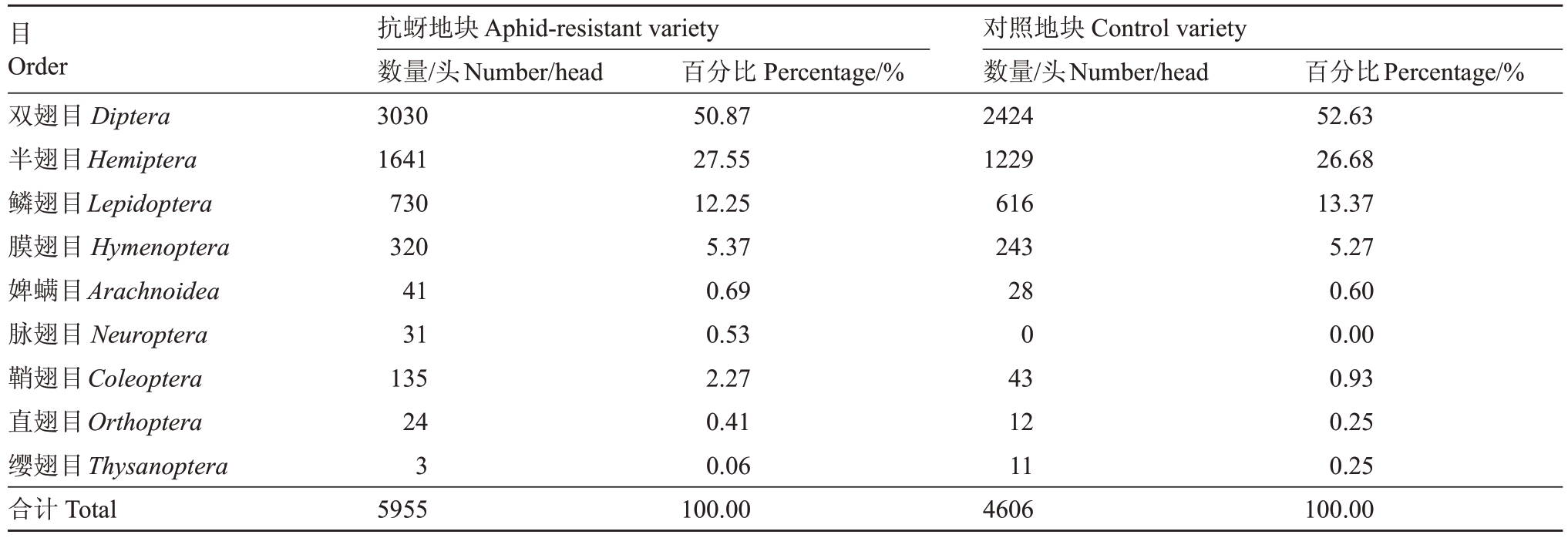
目Order双翅目Diptera半翅目Hemiptera鳞翅目Lepidoptera膜翅目Hymenoptera婢螨目Arachnoidea脉翅目Neuroptera鞘翅目Coleoptera直翅目Orthoptera缨翅目Thysanoptera合计Total抗蚜地块Aphid-resistant variety数量/头Number/head 3030 1641 730 320 41 31 135 24 3 5955百分比Percentage/%50.87 27.55 12.25 5.37 0.69 0.53 2.27 0.41 0.06 100.00对照地块Control variety数量/头Number/head 2424 1229 616 243 28 0 43 12 11 4606百分比Percentage/%52.63 26.68 13.37 5.27 0.60 0.00 0.93 0.25 0.25 100.00
在抗蚜地块和对照地块所诱集到的昆虫中,害虫包括鳞翅目、半翅目和婢螨目,抗蚜地块占总数量的40.70%,对照地块占总数量的35.93%。益虫包括食蚜蝇、瓢虫和草蛉,抗蚜地块占总数量的15.95%,对照地块占总数量的12.26%。
其他昆虫为中性昆虫,主要包括双翅目、鞘翅目、直翅目和缨翅目,抗蚜地块占总数量的43.35%,对照地块占总数量的51.81%(图1)。抗蚜地块和对照地块的益害虫比整体趋势没有较大差异。
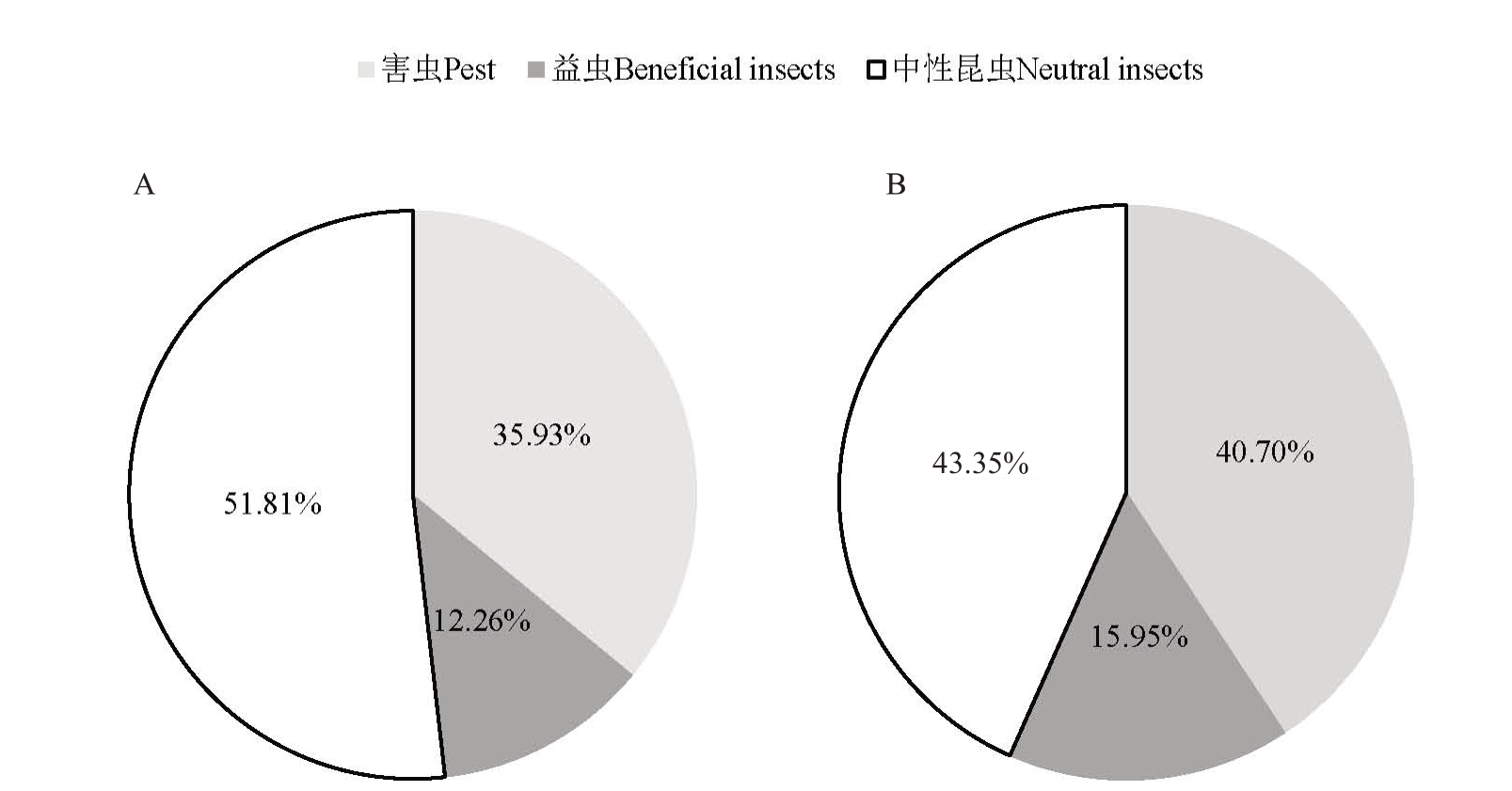
图1 抗蚜地块和对照地块益、害虫数量占比
Fig.1 The proportion of pests,beneficial insects and neutral insects in aphid-resistant variety and control variety
A.抗蚜地块益、害虫数量占比;B.对照地块益、害虫数量占比。
A.The proportion of beneficial insects in aphid-resistant variety;B.The proportion of beneficial insects in control variety.
2.2 抗蚜地块和对照地块内的昆虫群落个体总数量的动态变化
调查期间,抗蚜地块和对照地块昆虫个体总数随时间变化趋势基本一致。抗蚜地块和对照地块昆虫个体总数从3月下旬开始逐渐增加,在6月初达到峰值,分别达730、655 头,6 月上旬个体数迅速下降后又有所回升,直至8 月中旬两地块个体数均呈下降趋势(图2)。
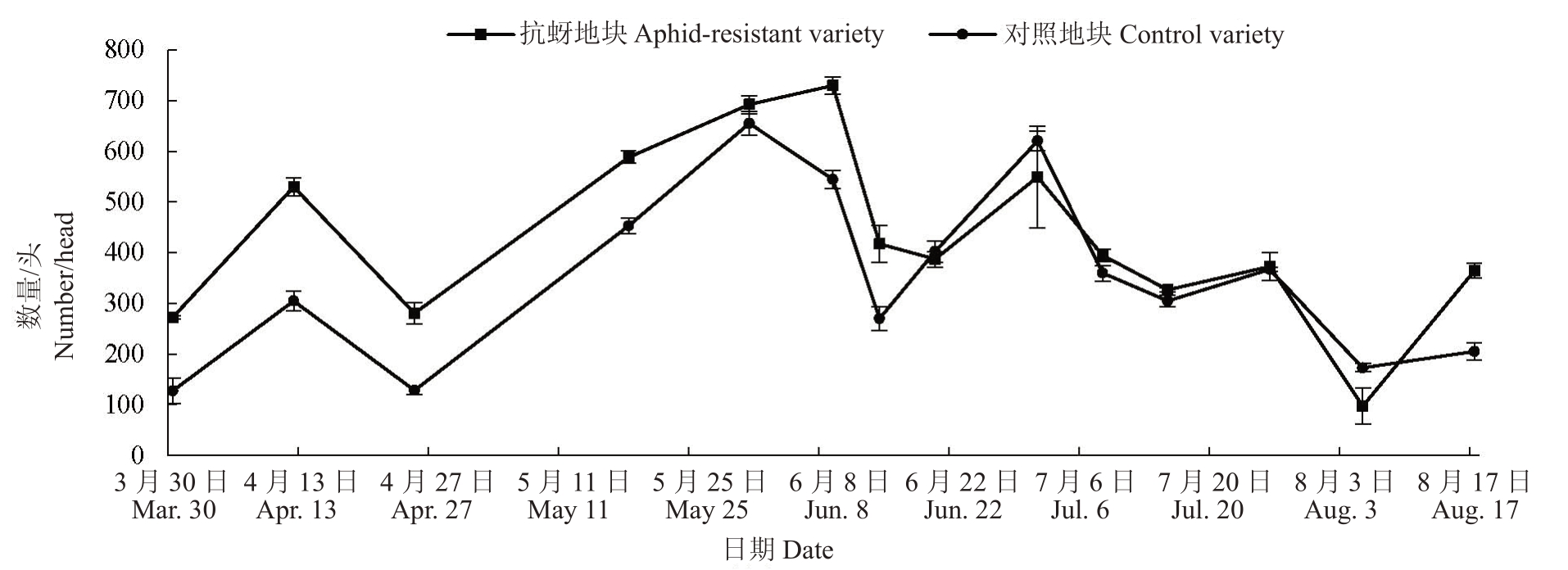
图2 抗蚜地块和对照地块昆虫总数的动态变化
Fig.2 Dynamic variation of the total number of insects in aphid-resistant variety and control variety
2.3 抗蚜地块和对照地块内的天敌昆虫群落个体数量的动态变化
本研究中统计了食蚜蝇和瓢虫这2类天敌昆虫在抗蚜地块和对照地块中个体数量的变化趋势情况(图3)。抗蚜地块中食蚜蝇的个体总数大多数时间点多于对照地块;食蚜蝇个体总数在两地块中均是4 月下旬迅速上升,5 月上旬达到峰值然后迅速下降。抗蚜地块中瓢虫的个体总数大多数时间点多于对照地块;瓢虫个体总数在4 月下旬逐渐上升,6 月中旬达到峰值,之后迅速下降。
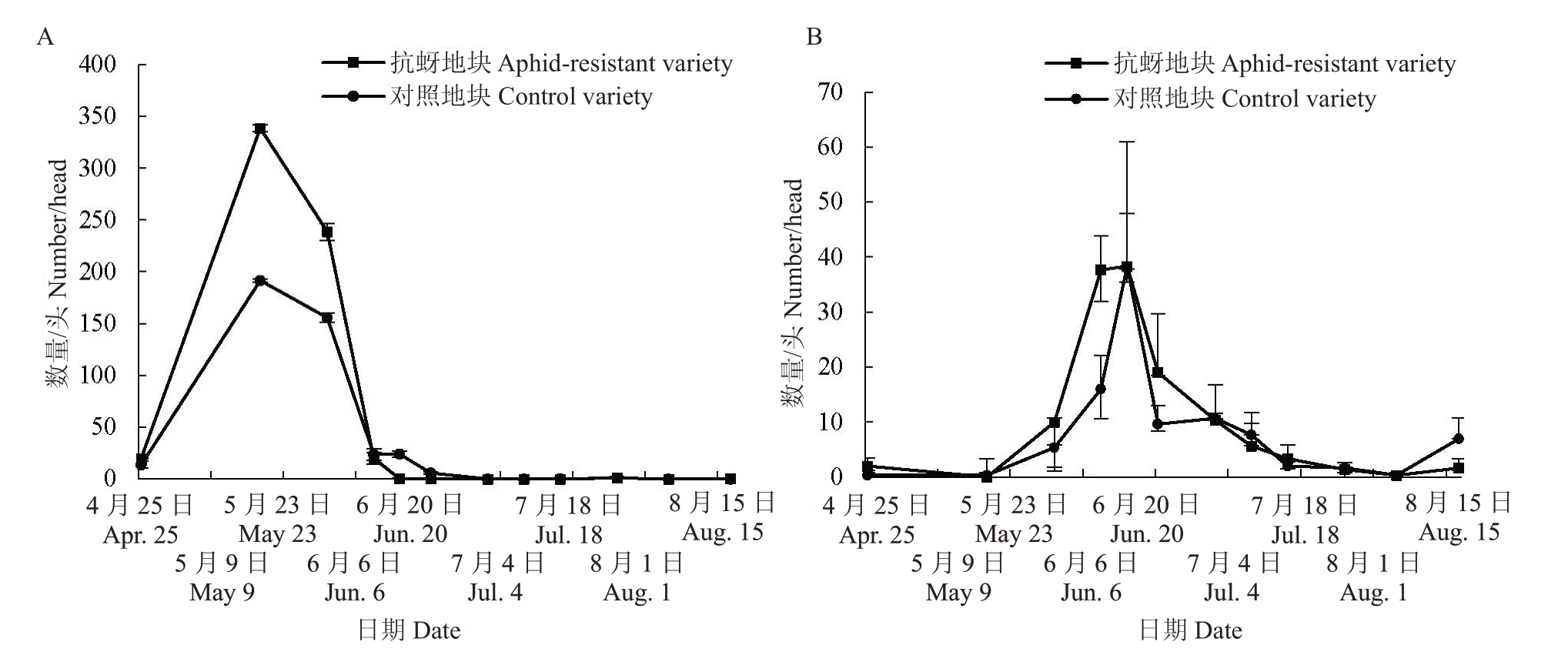
图3 抗蚜地块和对照地块中天敌昆虫的数量动态变化
Fig.3 Dynamic variation of the number of natural enemy insects in aphid-resistant variety and control variety
A.抗蚜地块和对照地块中食蚜蝇个体总数的动态变化;B.抗蚜地块和对照地块中瓢虫个体总数的动态变化。
A.Dynamic change of the total number of Syrphidae in aphid-resistant variety and control variety;B.Dynamic changes in the total number of Coccinellidae individuals in aphid-resistant variety and control variety.
2.4 抗蚜地块和对照地块内的桃树常见害虫群落个体数量的动态变化
笔者在本研究中统计了抗蚜地块和对照地块中桃树常见害虫包括梨小食心虫、桃小食心虫、苹小卷叶蛾和桃蛀螟(图4)。梨小食心虫的个体总数在抗蚜地块中于6 月中旬开始逐渐增加,在对照地块中于6月下旬开始逐渐增加,在两地块中均于7月上旬达到峰值,随后迅速降低。苹小卷叶蛾的个体总数在两地块中于6月中旬开始逐渐增加,7月上旬达到峰值,随后迅速降低。在发生期6 月中旬至7 月上旬,对照地块中的苹小卷叶蛾个体总数多于抗蚜地块。两地块内诱捕到的桃小食心虫和桃蛀螟的数量较少,抗蚜地块和对照地块之间趋势变化不明显。

图4 抗蚜地块和对照地块中常见害虫的数量动态变化
Fig.4 Dynamic changes of the number of common pests in aphid-resistant variety and control variety
A.抗蚜地块和对照地块中梨小食心虫个体总数的动态变化;B.抗蚜地块和对照地块中苹小卷叶蛾个体总数的动态变化;C.抗蚜地块和对照地块中桃小食心虫个体总数的动态变化;D.抗蚜地块和对照地块中桃蛀螟个体总数的动态变化。
A.Dynamic change of the total number of Grapholita molesta in aphid-resistant variety and control variety;B.Dynamic changes of the total number of Adoxophyes orana Fisher von Roslerstamm in aphid-resistant variety and control variety;C.Dynamic changes of the total number of Carposina sasakii in aphid-resistant variety and control variety;D.Dynamic changes of the total number of Dichocrocis punctiferalis in aphid-resistant variety and control variety.
2.5 抗蚜地块和对照地块内梨小食心虫虫梢数的动态变化
抗蚜地块和对照地块内的梨小食心虫的虫梢数随时间变化趋势基本一致。在抗蚜地块中,梨小食心虫的虫梢数从4月中旬开始迅速增加,6月下旬达到峰值,之后逐渐下降。在对照地块中,梨小食心虫的虫梢数从5月中旬开始迅速增加,6月下旬达到峰值,之后逐渐下降。比较得出抗蚜地块中的梨小食心虫虫害发生时间早于对照地块(图5)。
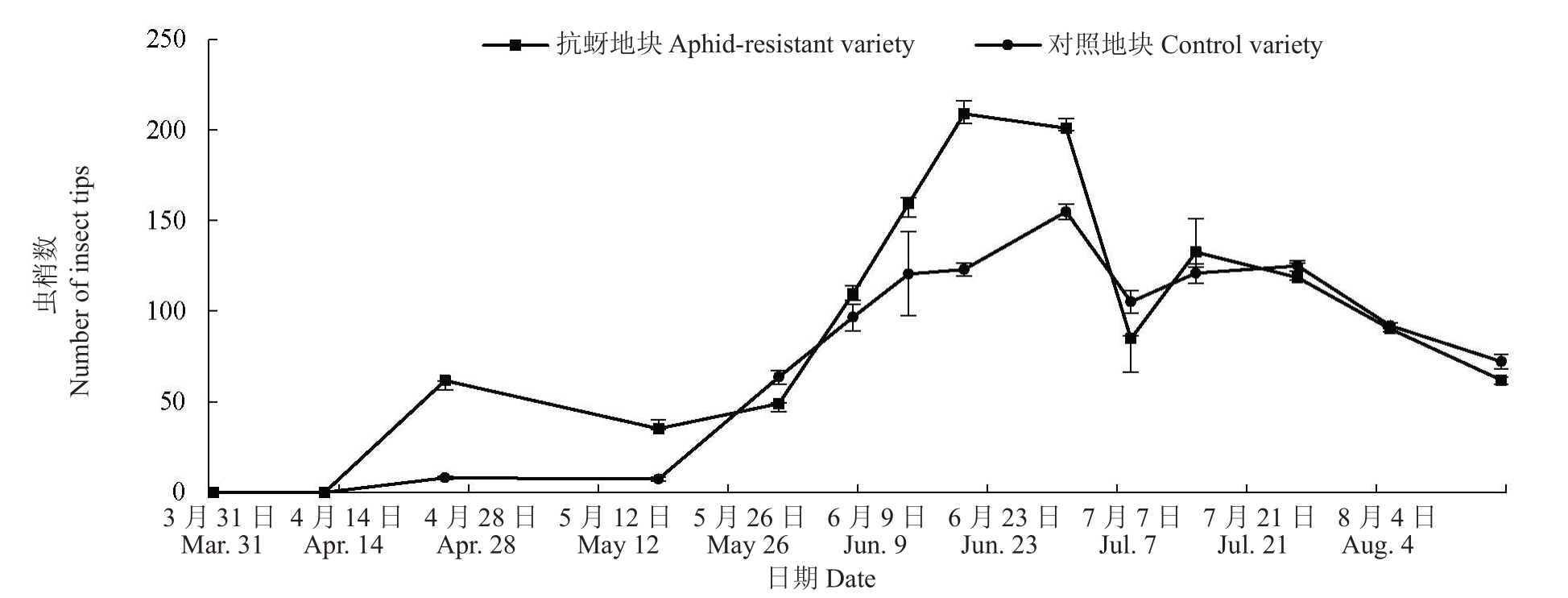
图5 抗蚜地块和对照地块中梨小食心虫虫梢数量的动态变化
Fig.5 Dynamic changes in the number of insect tips of G.molesta in aphid-resistant variety and control variety
3 讨 论
昆虫是种类最多、数量最大的动物类群,开展作物田间昆虫群落研究是农业害虫防治的基础[36-37]。已知,抗虫品种的推广应用会对作物田间昆虫群落产生影响。例如,通过回顾转基因BT抗虫棉的应用历史,转基因BT抗虫棉应用多年后,棉田间主要害虫(棉铃虫)虽然得到了很好的控制,但一些次要害虫的数量可能会大幅增加并成为主要害虫[24,38]。笔者课题组前期针对寿星桃类桃树抗蚜材料的抗性鉴定表明,寿星桃抗蚜材料对桃蚜具有强烈的趋避性抗性[11,39],抗蚜品种种植后能够控制桃蚜的危害。本研究对抗蚜地块和对照地块内的昆虫群落组成和昆虫群落个体数量的动态变化分析显示,综合全生长期数据,抗蚜地块内的昆虫个体总数大于对照地块;抗蚜地块前期(3 月下旬至6 月下旬)诱集到的昆虫总数大于对照地块,而这之后的昆虫数目基本一致,前期抗蚜地块昆虫总数升高可能是减少了桃蚜控制所使用的农药导致的。
抗虫作物如转基因抗虫作物在长期种植过程中对非靶标害虫的影响及防控研究已经成为各国科学家关注的焦点[25]。例如,在转基因抗虫棉田中,靶标害虫的有效控制使杀虫剂在Bt 转基因抗虫棉田中的使用模式发生了改变,从而导致多种害虫的种群地位和生态位空间出现了演替变化[40]。转基因Bt抗虫棉种植后,用于防治靶标害虫(棉铃虫)的化学农药使用次数减少到5 次[41]。然而,由于非靶标害虫(如蚜虫、叶蝉、盲蝽)数量的显著增加,用于防治非靶标害虫的化学农药的剂量比原来增加了接近一倍,因此,根据非靶标害虫的发生规律采取相应的防治措施对防治Bt 抗虫棉田间害虫非常必要。本研究中桃树非靶标害虫,如梨小食心虫也是桃栽培生产过程中的主要防治对象,相比对照地块,梨小食心虫在抗蚜地块内的发生时间提前,如不及时防治,将对桃树造成严重的危害。因此,笔者建议,在抗蚜品种应用过程中,更应该加强对梨小食心虫、苹小卷叶蛾、红蜘蛛和橘小食蝇等除桃蚜外桃树主要害虫的监测工作,了解这些桃树主要害虫的发生情况,科学适时开展针对性的防治工作,以避免对桃园造成的潜在危害。本试验开展对抗蚜地块中昆虫群落的种类和数量的研究,为将来抗蚜品种应用推广配套植保措施的制定提供了数据基础。
转基因抗虫作物的种植可以通过减少害虫数量而降低天敌种群数量,而转基因作物田间杀虫剂使用量的减少,又有利于天敌种群的增加[42]。本研究中,抗蚜地块和对照地块中昆虫群落个体总数随时间变化的整体趋势是一致的,但抗蚜地块昆虫总数出现了增加的现象,其中害虫总数和益虫总数同步增加,两地块之间益害虫比没有明显差异。但这并不是最终的结果,随着抗蚜品种应用时间变长,上一年度田间昆虫通过冬季休眠后会对次年田间昆虫群落造成影响。前人也有研究发现,次要害虫种群会在适宜的条件下逐渐发展成为田间的主要害虫,并导致次要害虫大暴发,这个过程需要持续很长时间才会出现,只有通过长期研究才能有效地评估和监测所有的潜在影响[43-44]。目前,本研究仅对桃树抗蚜品种短期应用后的昆虫群落结构特征进行了为期一年的调查与分析,试验周期短,桃树主要害虫的种群增长已经表现出提前的趋势,虽然部分变化确实并不非常显著,但仍值得笔者长期关注。因此,未来还需要开展更多针对抗蚜品种田间昆虫群落中昆虫种类和数量变化影响的长期研究工作。
4 结 论
综合本研究,发现抗蚜品种短期应用后,田间昆虫种类和昆虫总数的周年变化规律未发生较大变化,但抗蚜地块昆虫总数明显多于对照地块。与对照地块比较,抗蚜地块中的优势昆虫种群(双翅目、半翅目、鳞翅目和膜翅目)的昆虫总数存在发生高峰提前和总数增加的趋势。抗蚜地块中的多数中性昆虫和天敌昆虫的数量也存在发生高峰提前和总数增加的趋势。两地块益、害虫比无明显差异。笔者对抗蚜地块中昆虫群落的种类和数量进行了研究,为将来抗蚜品种应用推广配套植保措施的制定提供了有益参考。
[1] 牛良,鲁振华,曾文芳,崔国朝,潘磊,徐强,李国怀,王志强.‘粉寿星’对桃绿蚜抗性的遗传分析[J]. 果树学报,2016,33(5):578-584.NIU Liang,LU Zhenhua,ZENG Wenfang,CUI Guochao,PAN Lei,XU Qiang,LI Guohuai,WANG Zhiqiang. Inheritance analysis of resistance to green peach aphids(Myzus persicae Sulzer)for peach cultivar‘Fen Shouxing’(Prunus persica var.densa)[J].Journal of Fruit Science,2016,33(5):578-584.
[2] SMITH C M,CLEMENT S L. Molecular bases of plant resistance to arthropods[J]. Annual Review of Entomology,2012,57:309-328.
[3] CASTEEL C L,WALLING L L,PAINE T D.Behavior and biology of the tomato psyllid,Bactericerca cockerelli,in response to the Mi-1.2 gene[J].Entomologia Experimentalis et Applicata,2006,121(1):67-72.
[4] NOMBELA G,WILLIAMSON V M,MUÑIZ M.The root-knot nematode resistance gene Mi-1.2 of tomato is responsible for resistance against the whitefly Bemisia tabaci[J].Molecular Plant-Microbe Interactions,2003,16(7):645-649.
[5] ROSSI M,GOGGIN F L,MILLIGAN S B,KALOSHIAN I,ULLMAN D E,WILLIAMSON V M. The nematode resistance gene Mi of tomato confers resistance against the potato aphid[J].Proceedings of the National Academy of Sciences of the United States of America,1998,95(17):9750-9754.
[6] DOGIMONT C,CHOVELON V,TUAL S,BOISSOT N,RITTENER V,GIOVINAZZO N,BENDAHMANE A. Molecular diversity at the Vat/PM-W resistance locus in melon[C].Proceedings of the IXth EUCARPIA meeting on genetics and breeding of Cucurbitaceae. PITRAT M,ed. INRA, Avignon (France),2008:219-230.
[7] PASCAL T,ABERLENC R,CONFOLENT C,HOERTER M,LECERF E,TUÉRO C,LAMBERT P. Mapping of new resistance (Vr2,Rm1) and ornamental (Di2,pl) Mendelian trait loci in peach[J].Euphytica,2017,213(6):132.
[8] LAMBERT P,PASCAL T. Mapping Rm2 gene conferring resistance to the green peach aphid (Myzus persicae Sulzer) in the peach cultivar“Rubira®”[J].Tree Genetics & Genomes,2011,7(5):1057-1068.
[9] SAUGE M H,LAMBERT P,PASCAL T. Co-localisation of host plant resistance QTLs affecting the performance and feeding behaviour of the aphid Myzus persicae in the peach tree[J].Heredity,2012,108(3):292-301.
[10] 王力荣,朱更瑞,方伟超,左覃元,韩立新.桃种质资源对桃蚜的抗性评价[J].果树学报,2001,18(3):145-147.WANG Lirong,ZHU Gengrui,FANG Weichao,ZUO Qinyuan,HAN Lixin. Study on the resistance to peach aphid (Myzus persicae Sulzer) of peach germplasm[J]. Journal of Fruit Science,2001,18(3):145-147.
[11] NIU L,PAN L,ZENG W F,LU Z H,CUI G C,FAN M L,XU Q,WANG Z Q,LI G H. Dynamic transcriptomes of resistant and susceptible peach lines after infestation by green peach aphids (Myzus persicae Sulzer) reveal defence responses controlled by the Rm3 locus[J].BMC Genomics,2018,19(1):846.
[12] 张南南,鲁振华,崔国朝,潘磊,曾文芳,牛良,王志强. 基于SNP 标记桃抗蚜性状的基因定位[J].中国农业科学,2017,50(23):4613-4621.ZHANG Nannan,LU Zhenhua,CUI Guochao,PAN Lei,ZENG Wenfang,NIU Liang,WANG Zhiqiang.Gene mapping of aphidresistant for peach using SNP markers[J]. Scientia Agricultura Sinica,2017,50(23):4613-4621.
[13] 潘磊,闫乐乐,鲁振华,曾文芳,崔国朝,牛良,王志强.一类桃树桃蚜抗性新种质09 南3-30[J].果树学报,2021,38(6):895-900.PAN Lei,YAN Lele,LU Zhenhua,ZENG Wenfang,CUI Guochao,NIU Liang,WANG Zhiqiang. 09N3-30,a new peach germplasm with green peach aphid resistance[J]. Journal of Fruit Science,2021,38(6):895-900.
[14] 闫乐乐,卜璐璐,牛良,曾文芳,鲁振华,崔国朝,苗玉乐,潘磊,王志强.广泛靶向代谢组学解析桃蚜危害对桃树次生代谢产物的影响[J].中国农业科学,2022,55(6):1149-1158.YAN Lele,BU Lulu,NIU Liang,ZENG Wenfang,LU Zhenhua,CUI Guochao,MIAO Yule,PAN Lei,WANG Zhiqiang. Widely targeted metabolomics analysis of the effects of Myzus persicae feeding on Prunus persica secondary metabolites[J]. Scientia Agricultura Sinica,2022,55(6):1149-1158.
[15] 梁晋刚,张旭冬,毕研哲,王颢潜,张秀杰.转基因抗虫玉米发展现状与展望[J].中国生物工程杂志,2021,41(6):98-104.LIANG Jingang,ZHANG Xudong,BI Yanzhe,WANG Haoqian,ZHANG Xiujie. Development status and prospect of genetically modified insect-resistant maize[J]. China Biotechnology,2021,41(6):98-104.
[16] 李雪,朱永红,肖冰,李静,张换样,刘晓佩,梁晋刚.我国20 年转基因抗虫棉育种成果及转基因生物安全监管政策分析[J].农业科技管理,2022,41(2):41-43.LI Xue,ZHU Yonghong,XIAO Bing,LI Jing,ZHANG Huanyang,LIU Xiaopei,LIANG Jin’gang. Achievements of genetically modified insect-resistant cotton breeding and analysis of the safety regulatory and administration on agricultural GMOs in China in the last 20 years[J].Management of Agricultural Science and Technology,2022,41(2):41-43.
[17] WU K M,LU Y H,FENG H Q,JIANG Y Y,ZHAO J Z. Suppression of cotton bollworm in multiple crops in China in areas with Bt toxin-containing cotton[J]. Science,2008,321(5896):1676-1678.
[18] ZHAO J H,HO P,AZADI H. Benefits of Bt cotton counterbalanced by secondary pests?Perceptions of ecological change in China[J]. Environmental Monitoring and Assessment,2011,173(1/2/3/4):985-994.
[19] 苏军,黄季焜,乔方彬.转Bt 基因抗虫棉生产的经济效益分析[J].农业技术经济,2000(5):26-31.SU Jun,HUANG Jikun,QIAO Fangbin. Economic benefit analysis of Bt gene insect-resistant cotton production[J]. Journal of Agrotechnical Economics,2000(5):26-31.
[20] PRAY C E,HUANG J K,HU R F,ROZELLE S. Five years of Bt cotton in China- the benefits continue[J].The Plant Journal,2002,31(4):423-430.
[21] NARANJO S E. Impacts of Bt transgenic cotton on integrated pest management[J]. Journal of Agricultural and Food Chemistry,2011,59(11):5842-5851.
[22] QAIM M,ZILBERMAN D. Yield effects of genetically modified crops in developing countries[J].Science,2003,299(5608):900-902.
[23] WU K,LI W,FENG H,GUO Y.Seasonal abundance of the mirids,Lygus lucorum and Adelphocoris spp. (Hemiptera:Miridae)on Bt cotton in Northern China[J]. Crop Protection,2002,21(10):997-1002.
[24] 吴孔明,陆宴辉,王振营.我国农业害虫综合防治研究现状与展望[J].昆虫知识,2009,46(6):831-836.WU Kongming,LU Yanhui,WANG Zhenying.Advance in integrated pest management of crops in China[J]. Chinese Bulletin of Entomology,2009,46(6):831-836.
[25] 关正君,鲁顺保,霍艳林,郝浩永,曹建斌,魏伟,刘标.转Bt 基因抗虫作物对非靶标害虫的影响[J]. 生物多样性,2018,26(6):636-644.GUAN Zhengjun,LU Shunbao,HUO Yanlin,HAO Haoyong,CAO Jianbin,WEI Wei,LIU Biao. Effects of Bt crops on nontarget insect pests[J]. Biodiversity Science,2018,26(6):636-644.
[26] 吴启佳,崔旭红,张国安,梁宏合,焦晓国.Bt 水稻对青翅蚁形隐翅虫和非靶标害虫种群动态的影响[J].湖北大学学报(自然科学版),2016,38(5):445-448.WU Qijia,CUI Xuhong,ZHANG Guo’an,LIANG Honghe,JIAO Xiaoguo. Effects of transgenic Bt rice on population dynamics of dominant predator Paederus fuscipes Curtis and non-target phloem-sucking pests[J]. Journal of Hubei University (Natural Science),2016,38(5):445-448.
[27] 李博,龙正,陈金湘.转Bt 基因抗虫棉靶标害虫与非靶标害虫消长动态研究进展[J].作物研究,2011,25(6):634-638.LI Bo,LONG Zheng,CHEN Jinxiang.Research progress on the growth and decline dynamics of target and non-target pests of Bt gene insect-resistant cotton[J]. Crop Research,2011,25(6):634-638.
[28] 马惠,夏晓明,周玉,赵鸣,王红艳.转Bt 基因抗虫棉对非靶标昆虫的影响[J].中国农学通报,2009,25(7):214-218.MA Hui,XIA Xiaoming,ZHOU Yu,ZHAO Ming,WANG Hongyan. Impact of transgenic Bt cotton on Non-target insects[J].Chinese Agricultural Science Bulletin,2009,25(7):214-218.
[29] 陈彦君,关潇,任梦云.转Cry1Ah 基因抗虫玉米HGK60 对田间节肢动物及杂草多样性的影响[J].应用生态学报,2020,31(12):4180-4188.CHEN Yanjun,GUAN Xiao,REN Mengyun. Impacts of transgenic insect-resistant maize HGK60 with Cry1Ah gene on biodiversity of arthropods and weeds in the field[J]. Chinese Journal of Applied Ecology,2020,31(12):4180-4188.
[30] 尹俊琦,武奉慈,周琳,宋新元.转Cry1Ac 基因抗虫玉米Bt-799 对田间节肢动物群落多样性的影响[J]. 生物安全学报,2017,26(2):159-167.YIN Junqi,WU Fengci,ZHOU Lin,SONG Xinyuan.Impacts of a transgenic insect-resistant maize(Bt-799)containing a Cry1Ac gene on arthropod biodiversity[J].Journal of Biosafety,2017,26(2):159-167.
[31] 曾华兰,何炼,叶鹏盛,刘朝辉,韦树谷,张骞方.四川棉区转基因抗虫棉对棉田昆虫群落的影响[J].西南农业学报,2009,22(3):632-635.ZENG Hualan,HE Lian,YE Pengsheng,LIU Zhaohui,WEI Shugu,ZHANG Qianfang.Effect of transgenic cotton on the population dynamics of insect in Sichuan cotton region[J]. Southwest China Journal of Agricultural Sciences,2009,22(3):632-635.
[32] 徐文华,刘标,王瑞明,郑央萍,张毅,李孝刚.江苏沿海地区转Bt 基因抗虫棉对棉田昆虫种群的影响[J].生态与农村环境学报,2008,24(1):32-38.XU Wenhua,LIU Biao,WANG Ruiming,ZHENG Yangping,ZHANG Yi,LI Xiaogang. Effects of transgenic Bt cotton on insect populations in cotton fields in coastal agricultural region of Jiangsu Province[J].Journal of Ecology and Rural Environment,2008,24(1):32-38.
[33] 冯纪年.动物志(昆虫纲)[M].北京:科学出版社,2021.FENG Jinian.Fauna(insecta)[M].Beijing:Sience Press,2021.
[34] 张巍巍,李元胜.中国昆虫生态大图鉴[M].重庆:重庆大学出版社,2019.ZHAGN Weiwei,LI Yuansheng.Chinese insect ecology map[M].Chongqing:Chongqing University Press,2019.
[35] 王天元.桃病虫害快速鉴别与防治妙招[M].北京:化学工业出版社,2019.WANG Tianyuan. Quick identification and control of peach pests and diseases[M].Beijing:Chemical Industry Press,2019.
[36] 邹运鼎,毕守东,周夏芝,李磊,高彩球,丁程成.桃园害虫及天敌群落动态研究[J].应用生态学报,2003,14(5):717-720.ZOU Yunding,BI Shoudong,ZHOU Xiazhi,LI Lei,GAO Caiqiu,DING Chengcheng. Dynamics of the pest and natural enemy communities in peach orchards[J]. Chinese Journal of Applied Ecology,2003,14(5):717-720.
[37] 巫厚长,程遐年,魏重生,邹运鼎.吡虫啉对烟田节肢动物群落的影响研究[J].应用生态学报,2004,15(1):95-98.WU Houchang,CHENG Xianian,WEI Chongsheng,ZOU Yunding.Effects of imidacloprid on arthropod community structure in tobacco field[J]. Chinese Journal of Applied Ecology,2004,15(1):95-98.
[38] 赵微微.苹果园次要害虫发生及防治[J].农民致富之友,2016(4):79.ZHAO Weiwei.Occurrence and control of secondary pests in apple orchard[J].Nongmin Zhi Fu Zhi You,2016(4):79.
[39] PAN L,LU Z H,YAN L L,ZENG W F,SHEN Z J,YU M L,BU L L,CUI G C,NIU L,WANG Z Q.NLR1 is a strong candidate for the Rm3 dominant green peach aphid (Myzus persicae)resistance trait in peach[J]. Journal of Experimental Botany,2022,73(5):1357-1369.
[40] 陆宴辉. Bt 棉花害虫综合治理研究前沿[J]. 应用昆虫学报,2012,49(4):809-819.LU Yanhui. Advance in insect pest management in Bt cotton worldwide[J].Chinese Journal of Applied Entomology,2012,49(4):809-819.
[41] NARANJO S E. Impacts of Bt transgenic cotton on integrated pest management[J]. Journal of Agricultural and Food Chemistry,2011,59(11):5842-5851.
[42] 周霞,谢翔,左娇,谭燕华,曹扬,霍姗姗,易小平,赵辉,张丽丽,郭安平.转基因作物对天敌的影响研究进展[J].环境昆虫学报,2018,40(5):1021-1026.ZHOU Xia,XIE Xiang,ZUO Jiao,TAN Yanhua,CAO Yang,HUO Shanshan,YI Xiaoping,ZHAO Hui,ZHANG Lili,GUO Anping.The advance on the effects of transgenic crops on natural enemies[J]. Journal of Environmental Entomology,2018,40(5):1021-1026.
[43] LU Y H,WU K M,JIANG Y Y,XIA B,LI P,FENG H Q,WYCKHUYS K A G,GUO Y Y. Mirid bug outbreaks in multiple crops correlated with wide-scale adoption of Bt cotton in China[J].Science,2010,328(5982):1151-1154.
[44] CATARINO R,CEDDIA G,AREAL F J,PARK J. The impact of secondary pests on Bacillus thuringiensis (Bt) crops[J]. Plant Biotechnology Journal,2015,13(5):601-612.